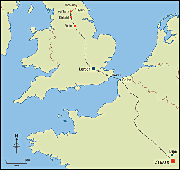 |
 |
 |
 |
 |
 |
 |
|
Fountains Abbey: History
Fountains Abbey: Buildings
|
Unfavourable conditions: problems faced and weathered (18/26) It happened in those days that King John … hated
the sons of the Order
The first half of the thirteenth century was a high point for Fountains. This was in spite of the unfavourable conditions that faced the Cistercians in England and the country at large. These difficulties were essentially caused by King John (1199-1216), whose hefty exactions in 1200 and 1210 devastated the kingdom. Whereas the White Monks had previously enjoyed exemption from taxation, they were no longer spared and Fountains, like a number of other Cistercian communities, was hit hard by these excessive royal demands which amounted to some £800.(72) Indeed, the monks were forced to disband temporarily until the abbey’s finances could be recouped. Unlike many other communities, however, Fountains had the necessary resources to bounce back. Fountains soon recovered its position as a leading house in the North of England, and was able to launch an impressive building programme. Fountains was not only burdened with royal exactions but was saddled with demands from the Church and also the General Chapter. There were requests for payments, orders to act as arbiters and envoys, and the abbots were expected to attend the General Chapter meeting at Cîteaux each year. These multiple allegiances sometimes led to a clash of interests. Whereas the abbot of Fountains ignored the king’s summons to court in 1212 and instead attended the annual General Chapter, he was prevented from attending the Chapter of 1242 when the archbishop of York refused all the Cistercian abbots in his diocese permission to leave, since they had refused to pay King Henry the wool crop he had demanded to subsidise war; the monks’ offer of prayers as an alternative, was evidently deemed inadequate.(73) When the Cistercians in England made a payment to Henry III in 1233, they were reprimanded by the General Chapter who punished the abbots of the four leading abbeys in England for failing to defend their immunity. These four abbots were from Waverley, Fountains, Rievaulx and Furness.(74) |
